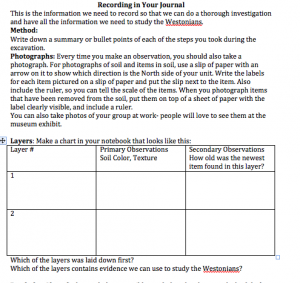This course focused in part on presentation of archaeology to the public, both how and why. I believe that one of the strongest benefits that the discipline of archaeology can provide to the public is through education. Archaeology makes history tangible and local, so students who learn history through archaeology are learning in a way that makes history personally relevant to them.
I chose to create a classroom unit based on this belief. My project consists of five lessons created with fourth graders from my hometown of Weston, CT in mind. The lessons teach the history of Native Americans in the Connecticut area from the first inhabitants of the area 10,000 years ago to the colonial period alongside lessons in archaeological methods. Though students would by no means gain a complete knowledge of either archaeology or American Indian history and culture from this unit, the unit was created with the goal of having each topic reinforce the other, with the result that students are interested in retaining the information they learn and continuing to learn on their own.

One of the highlights of the unit I have created is the final lesson, a mock excavation in which students form groups to carefully excavate artificial plots of land, then record data about artifacts, ecofacts, and environmental conditions, and finally build a mini-museum. As a hands-on experience, the excavation should capture students’ attention and motivate them to carefully consider what they have learned. The mock excavation, with its focus on data recording and collaboration with teammates and stakeholders, also works to eliminate stereotypes and misconceptions the general public may have about archaeology.
All contributors to this blog are authorized to view the unit guide and the accompanying PowerPoint presentation, both stored on Vspace. Anyone else interested in seeing the project can contact me at caclevenger@vassar.edu for permission.
